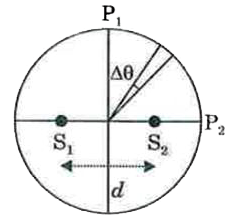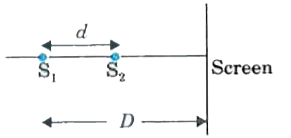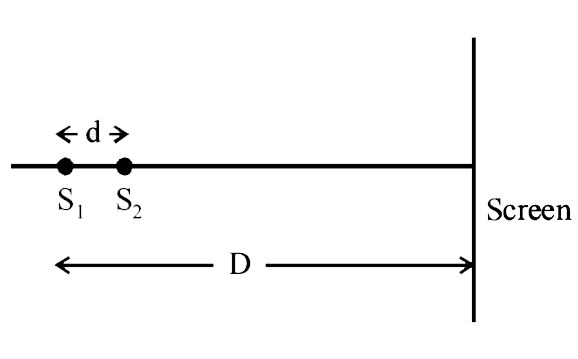Two coherent monochromatic point sources S1andS2 of wavelength λ=600nm are placed symmetrically on either side of the centre of the circle as shown. The sources are separated by a distance d=1.8mm. This arrangement produces interference fringes visible as alternate bright and dark spots on the circumference of the circle. The angular separation between two consecutive bright spots is Δθ. Which of the following options is/are correct ?

The total number of fringes produced between P1andP2 in the first quadrant is close to 3000
A dark spot will be formed at point P2
At P2 the order of the fringe will be maximum
The angular separation between two consecutive brigth spots decreases as we move from P1 to P2 along the first quadrant.
The correct Answer is:A, C
Path difference between the waves arriving at point P1 from sources is zero because this point is equidistant from sources, hence there will be a bright at point P1. As we move from P1 towards P2 path difference increases and it becomes maximum at point P2. At the point P2 this maximum possible path difference is equal to distance (1.8 mm) between the sources. Let this path difference at point P2 in n times the wavelength λ. We can write the following:
n=dλ=1.8×10−3600×10−9=3000
We can see that option (a) is correct. Moreover path difference at point P is integral (n = 3000) multiple of wavelength, hence there will be bright at the point P2. Hence option (b) is not correct but option (c ) is correct.
We shall now calculate path difference between waves arriving at point P from the two sources and for this calculation we shall assume that radius of the circle is much greater than the separation between sources. OP makes an angle θ with the line joining sources. Since radius is very large, we can treat lines S1P,OPandS2P almost parallel to each other. M is the foot of perpendicular drawn from S2on S1P.
Path difference (x)=S2P−S1P≈S1M
Angle MS1S2 is also approximately θ, hence in triangle MS1S2 we can write the following:
cosθ=S1MS1S2
⇒cosθ=xd⇒x=dcosθ
We can differentiate the above relation.
dxdθ=−dsinθ⇒ΔxΔθ=−dsinθ
⇒Δx=−(dsinθ)Δθ
Δx is the difference prodced in the path difference as we move further by an angle Δθ. For consecutive fringes, difference in path difference must be λ. Hence if we assume Δx equal to λ, then Δθ will be the angular fringe width. Hence angular fringe width can be written as follows:
⇒|Δθ|=λdsinθ
As we move from P1 towards P2, value of θ decreases from 90 to 0, hence sinθ decrease which means angular fringe width Δθ increases.

Topper's Solved these Questions
- WAVE OPTICALBOOK - MODERN PUBLICATIONCHAPTER - WAVE OPTICALEXERCISE - OBJECTIVE TYPE QUESTIONS (D. MULTIPLE CHOICE QUESTIONS)
7 Videos
- WAVE OPTICALBOOK - MODERN PUBLICATIONCHAPTER - WAVE OPTICALEXERCISE - OBJECTIVE TYPE QUESTIONS (ASSERTION REASON TYPE QUESTIONS)
10 Videos
- WAVE OPTICALBOOK - MODERN PUBLICATIONCHAPTER - WAVE OPTICALEXERCISE - OBJECTIVE TYPE QUESTIONS (JEE (ADVANCED) FOR IIT ENTRANCE)
6 Videos
- SEMICONDUCTOR ELECTRONICS METERIALS DEVICES AND SIMPLE CIRCUITS BOOK - MODERN PUBLICATIONCHAPTER - SEMICONDUCTOR ELECTRONICS METERIALS DEVICES AND SIMPLE CIRCUITS EXERCISE - CHAPTER PRACTICE TEST FOR BOARD EXAMINATION
12 Videos
Similar Questions
Knowledge Check
Two coherent point sources S1andS2 are separated by a small distance 'd' as shown. The fringes obtained on the screen will be :
 Astraigth linesBsemi-circleCconcentric circlesDpoints
Astraigth linesBsemi-circleCconcentric circlesDpointsTwo coherent point sources S1 and S2 are separated by a small distance d as shown. The fringes obtained on the screen will be
 ApointsBstraight linesCsemi-circlesDconcentric circles
ApointsBstraight linesCsemi-circlesDconcentric circlesTwo coherent light sources S1 and S2(λ=6000Å) are 1mm apart from each other. The screen is placed at a distance of 25cm from the sources. The width of the fringes on the screen should be
A(a) 0.015cmB(b) 0.025cmC(c) 0.010cmD(d) 0.030cm
Two coherent sources S1 and S2 are separated by a small distance d. The fringes obtained on the screen will be:

View SolutionTwo coherent light sources S1 and S2(λ=6000Å) are 1mm apart from each other. The screen is placed at a distance of 25cm from the sources. The width of the fringes on the screen should be
View SolutionThe two coherent sources with intensity ratio β produce interference. The fringe visibility will be
View SolutionTwo coherent sources separated by distance d are radiating in phase having wavelength λ. A detector moves in a big circle around the two sources in the plane of the two sources. The angular position of n=4 interference maxima is given as

View SolutionThe two coherent sources with intensity ratio β produce interference. The fringe visibility will be
View Solution
